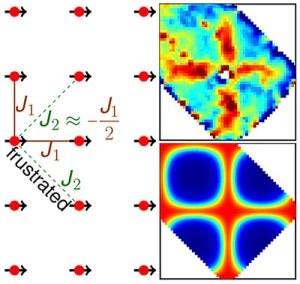Nov 10 2017
The existence of an unusual disordered electron spin state in a metal has been discovered and described by Ames Laboratory of the U.S. Department of Energy. This breakthrough may offer a unique way for searching and exploring frustrated magnets.
 A diagram modeling competing or "frustrated" magnetic states in neighboring electrons. Condensed matter physicists use the term “frustrated” to describe a kind of magnet in which the spins fail to align into stable magnetic order. Their unique properties are of interest in the development of quantum computing and high-temperature superconductivity. Credit: Ames Laboratory
A diagram modeling competing or "frustrated" magnetic states in neighboring electrons. Condensed matter physicists use the term “frustrated” to describe a kind of magnet in which the spins fail to align into stable magnetic order. Their unique properties are of interest in the development of quantum computing and high-temperature superconductivity. Credit: Ames Laboratory
The term “frustrated” is used by condensed matter physicists to describe a type of magnet, wherein the spins do not align into a stable magnetic order. Spin liquids are perfectly frustrated magnets, in which the disordered magnetism persists even at extremely low temperatures. The exceptional properties of these materials have attracted a great deal of interest in the development of high-temperature superconductivity and quantum computing.
Insulators are typically used to locate this perfectly frustrated magnetic state; however, Researchers at Ames Laboratory were able to successfully define a “perfectly frustrated” state in CaCo1.86As2. – a type of metallic material.
Perfectly frustrated systems, ones that really cannot resolve their magnetic states, are difficult to find in the first place, but even more so in a metal.
Rob McQueeney, Scientist, Ames Laboratory
In insulating magnets, the lattice’s crystal structure sets the interactions between spins that cause frustration, and these interactions are relatively unchangeable. The finding of this almost perfectly frustrated metal presents new opportunities to tinker with the magnetic interactions to obtain perfect frustration.
Here, we have a little knob that we can tune. We know that some of these interactions that lead to frustration are mediated by conduction electrons, and we can tune a number of those very accurately—maybe you get a superconductor, maybe some other novel quantum state. There’s a lot of promise there.
Rob McQueeney, Scientist, Ames Laboratory
The study has been reported in Physical Review Letters and is further described in the paper titled “Effective One-Dimensional Coupling in the Highly Frustrated Square-Lattice Itinerant Magnet CaCo2-yAs2,” Authored by A. Sapkota, B.G. Ueland, V.K. Anand, N.S. Sangeetha, D.L. Abernathy, M.B. Stone J.L. Niedziela, D.C. Johnston, A. Kreyssig, A.I. Goldman, and R.J. McQueeney.
The study also utilized resources at the Spallation Neutron Source, a DOE Office of Science User Facility operated by Oak Ridge National Laboratory.
Ames Laboratory is a U.S. Department of Energy Office of Science national laboratory operated by Iowa State University. It develops novel technologies, energy solutions and materials, and uses its unique capabilities, expertise and interdisciplinary collaborations to resolve problems across the world.
DOE’s Office of Science, the single largest supporter of basic research in the physical sciences in the U.S., is working to address some of the most urgent issues of our time.